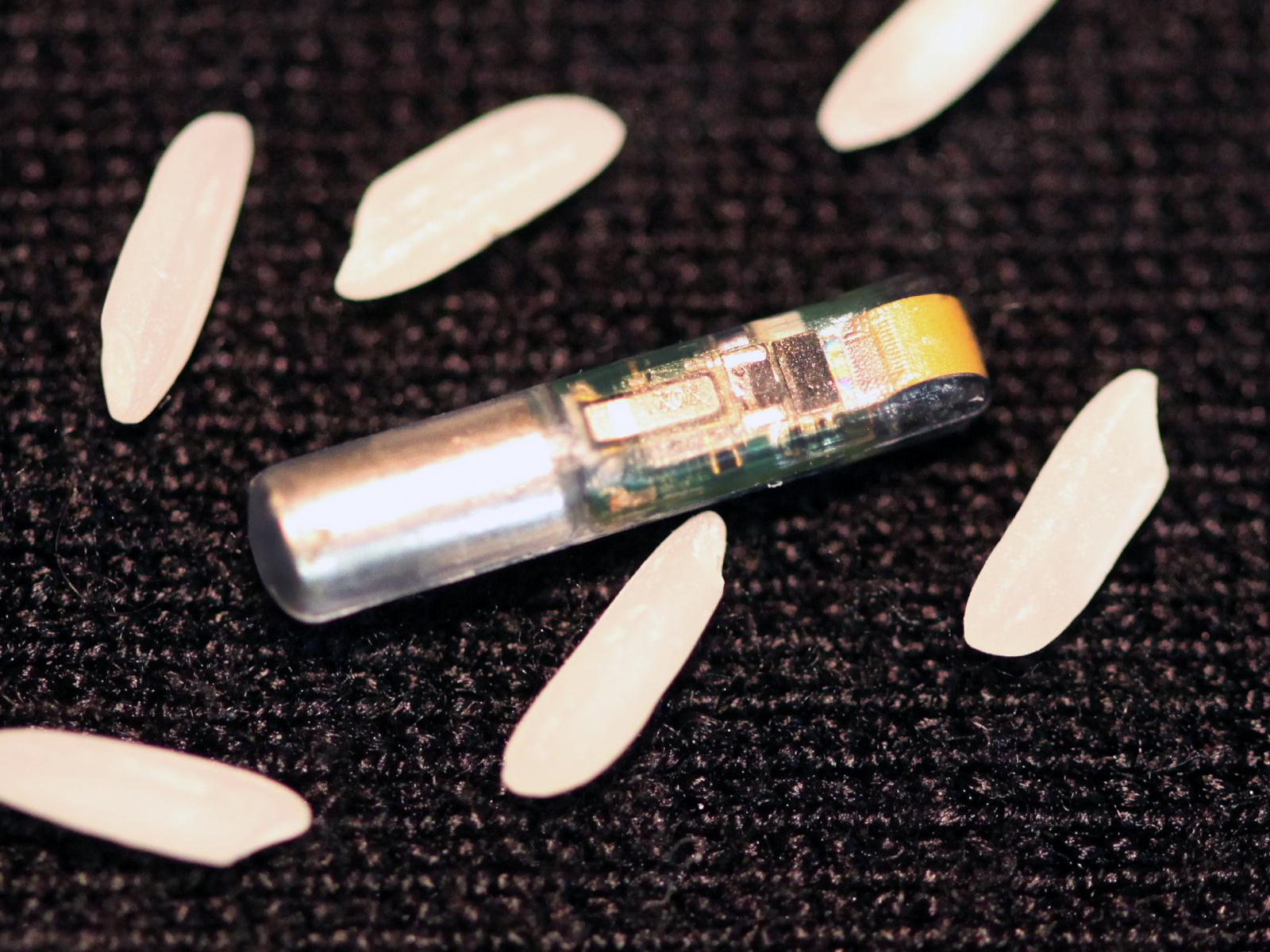PNNL’s Role in Environmentally Sustainable Hydropower

These tiny tags help monitor how and where juvenile salmon travel during their journey from the Columbia River Basin to the Pacific Ocean. Earlier versions of the tags were larger and had to be surgically implanted, but today they are 30 percent lighter, last four times longer and can be safely injected with a syringe in about 20 seconds. PNNL also established an accredited underwater acoustic lab to meet rigorous project requirements. Learn more at pnnl.gov/technology/jsats
(Photo by Pacific Northwest National Laboratory)
The Northwest and the nation depend on hydroelectricity as a clean source of power. While it accounts for only about seven percent of the nation's overall power production, it represents about half of the renewable energy in the United States. Here in Washington, more than 70 percent of our energy comes from hydroelectric dams.
For decades, the Department of Energy's Pacific Northwest National Laboratory (PNNL) has played a role in establishing and maintaining sustainable hydropower for the region. With President Obama's goal to double the nation's hydropower by 2030, our research will be even more important in the coming years.
Our work in this area is one example of how we are making our science vision a reality. At PNNL, we strive to understand, predict, and control the behavior of complex systems.
Two such systems are the earth system and energy system, each of which is complex on its own—but even more so when we consider the interactions between them.
When it comes to hydroelectricity, our researchers are exploring the impacts of hydroelectric power production on the environment and vice versa. For example, our Sustainable Hydropower Program focuses on the design of new, more efficient turbines and how best to safeguard fish populations.
Making dams fish friendly
Working with the Bonneville Power Administration and the U.S. Army Corps of Engineers, we are helping understand the hazards fish face as they encounter dams during their migration from the Columbia River Basin to the Pacific Ocean.
The Juvenile Salmon Acoustic Telemetry System, or JSATS, involves injecting fish with tiny tags that emit signals that are uniquely coded for each individual fish. The signals are transmitted as often as every 0.4 seconds and are picked up by receivers in rivers, lakes and other bodies of water as the tagged fish swim by.
With the data collected from thousands of fish, researchers can map the precise location of each fish during its journey and whether it has been injured. JSATS is helping understand risks to fish survivability and how to mitigate them through dam operations and more fish-friendly turbines.
With support from DOE's Office of Energy Efficiency and Renewable Energy and others, we are conducting other studies to understand fish behavior and mortality. For example, we have invented a robotic "sensor" fish to measure and analyze the physical stresses that fish experience.
Our research is helping to improve dam operations and provide input to the design of new turbines that will replace 90 aging ones in Columbia Basin dams over the next 50 years. PNNL is also supporting the development of international hydropower and the development of new hydro systems.
Climate change and hydropower
PNNL scientists and engineers also are studying how changes in the earth system might affect hydroelectric power production by taking an innovative look at the interdependencies between water, climate and power.
Our research can help decision makers understand and evaluate the tradeoffs in times of stress between water for power production and competing purposes such as irrigation within and across regions.
A team of climate scientists, hydrologists and power engineers is assessing the impact of droughts, heat waves and wild fires on the reliability of the electricity grid and energy production costs. They are integrating projections of where and how much water will be available at different places and times with where and how electricity is generated and where and how much energy is needed.
A new project will bring future droughts into the equation and focus specifically on the Western Interconnect—the power grid that serves the western United States and parts of Canada and Mexico.
Research like this could inform water management decisions and electricity generation planning and operations to help minimize the economic impacts of drought, as well as reduce the strain it can put on the electric grid.
Other alternatives
Beyond hydroelectricity, there are other ways to harness renewable energy sources from the sun, wind and water that can reduce our carbon footprint and dependence on fossil fuels.
At the Marine Sciences Laboratory in Sequim, our scientists are addressing the environmental challenges facing energy production from offshore wind, waves and tides. They are collaborating with industry, academia and other national laboratories to devise and evaluate technologies ranging from controlling biofouling on marine turbines to automatically detecting orca whales and birds for tidal turbine and offshore wind projects.
These are but a few of the exciting research projects conducted at PNNL that seek to develop and deploy sustainable energy solutions for our nation and the world. The next time you turn on a light or charge your cell phone, know that PNNL and our partners are working to ensure that the electricity used is clean and environmentally friendly.
Steven Ashby, director of Pacific Northwest National Laboratory, writes this column monthly. To read previous Director's Columns, visit pnnl.gov/news and filter by Director's Columns in our Latest Stories.
Published: June 7, 2015